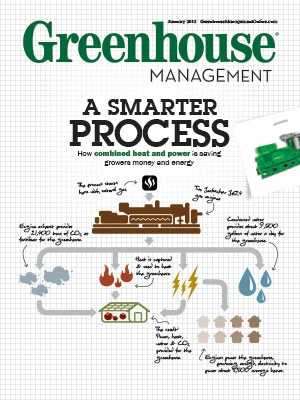|
The goal when setting up a mist system is to get uniform coverage of the growing area. Factors that need to be considered include nozzle type, location, spacing, water pressure and drip prevention. Mist particles are generally considered to be particles from about 30 to 100 microns in diameter. As a comparison, the human hair is about 0.004 in diameter, or about 100 microns. Fog, on the other hand, has particles less than 30 microns. There are about 68 billion droplets — in the size of 50 microns — in a gallon of water. There are many choices in mist nozzles. They can be made of plastic, brass, stainless steel or ceramic. Today, most nozzles are made of high quality plastic. They are durable, ultra-violet resistant and low-cost. Brass and stainless steel nozzles have a longer life and maintain the pattern better. Although they cost more, ceramic nozzles have better chemical resistance and will last 20 to 30 times longer than a stainless steel nozzle, and several hundred times longer than one made of brass. Two basic types of nozzles are used. Impingement nozzles spread the water from a small stream impacting against a plate or pin. The pattern is a round horizontal circle with a pattern that varies in intensity over its radius. Whirling nozzles use small slots within the body to break up the water into droplets, which are then thrown out in a circular pattern. Nozzles producing a fan- or cone-spray pattern are commonly used on boom systems. The design of the nozzle determines the capacity, spray angle and spray pattern. Mist nozzles have an opening of only a few microns. The larger the opening, the more water that is supplied. Increasing the water pressure increases the flow rate and droplet size. Most mist nozzles have an output of less than 10 gallons/hour. Nozzles do not generate droplets of uniform size. This creates a non-uniform pattern. Due to greater momentum, the larger droplets are thrown to the outside of the pattern. Induced air pushes the smaller droplets toward the center. A good way to check the uniformity of the pattern is to place small cans in the plant canopy and compare the water collected over a period of time.
Unless a pressure regulator is installed or municipal water is used, water pressure will vary. Most pressure tank systems have variations of 15 to 20 psi between when the pump starts and when the tank is fully charged. This can affect the flow rate, droplet size and diameter of the pattern. Operating the nozzle outside of the recommended pressure range can also give poor results. To prevent the supply line from draining after the water is turned off, some manufacturers incorporate a check valve at the nozzle. To remove solids that could clog the opening requires a fine filter, usually 100 to 150 mesh. In addition to the recommended inline filter, a filter may be incorporated into the nozzle body. Good propagation requires a balance between humidity and transpiration. The foliage needs to be kept moist without saturating the soil. A well-designed mist system can provide this balance. Have a question? You can write John at jbartok@rcn.com. |

Explore the January 2013 Issue
Check out more from this issue and find your next story to read.
Latest from Greenhouse Management
- Anthura acquires Bromelia assets from Corn. Bak in Netherlands
- Top 10 stories for National Poinsettia Day
- Langendoen Mechanical hosts open house to showcase new greenhouse build
- Conor Foy joins EHR's national sales team
- Pantone announces its 2026 Color of the Year
- Syngenta granted federal registration for Trefinti nematicide/fungicide in ornamental market
- A legacy of influence
- HILA 2025 video highlights: John Gaydos of Proven Winners
.jpg)






